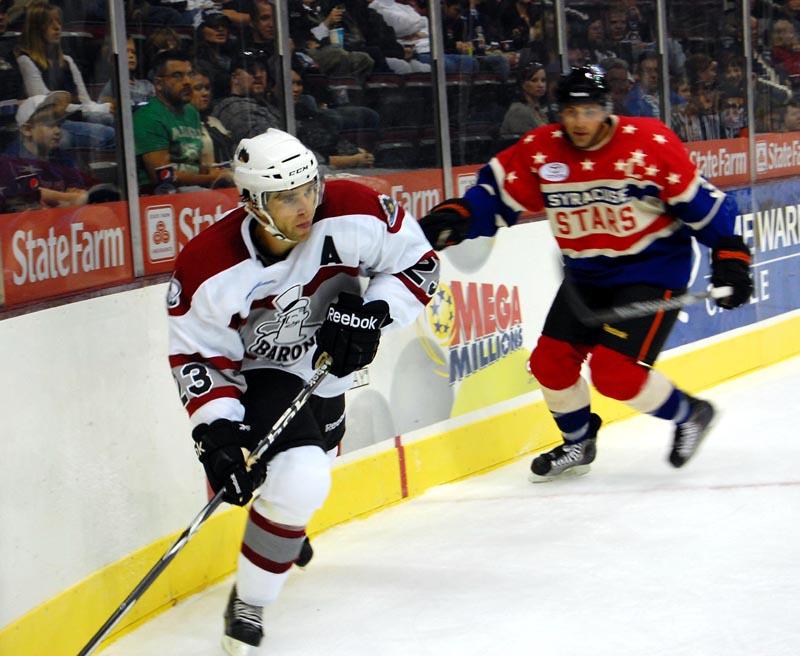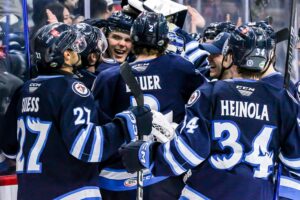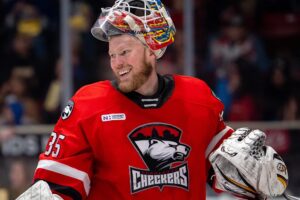by Keegan Welsh || AHL On The Beat Archive
The city of Cleveland has been home to professional hockey for parts of eight decades and it is one the AHL’s charter cities.
In honoring the 75th anniversary of the AHL, the Monsters began their season by hosting Syracuse, another one of the league’s original cities.
Both sides donned throwback sweaters that replicated their original teams. Syracuse represented the jerseys of the Syracuse Stars, while the Monsters sported the uniforms of the Cleveland Barons, who captured 10 division titles and nine Calder Cup Championships between 1936 and 1973.
Lake Erie not only represented the Barons in a 3-2 come-from-behind win that night, but the seven other professional hockey teams that have played in the city of Cleveland.
Prior to the era of the Cleveland Barons were the International Hockey League’s Cleveland Indians (1929-1933), who became the Cleveland Falcons in 1934. The Falcons played their home games at Elysium Arena and became the first American Hockey League team in Cleveland, changing their name to the Barons in 1937.
The original Barons were highlighted by standout Fred Glover, the team’s leader in goals, assists, points, penalty minutes and years played and one of the inaugural inductees into the American Hockey League Hall of Fame in 2006.
Another notable player from that era was Les Cunningham. After being named a league all-star five times, the AHL’s MVP award was named after Cunningham for his individual success.
In 1972, the Cleveland Crusaders of the World Hockey Association began playing at Cleveland Arena. As a WHA team, the Crusaders were allowed to hire former National Hockey League players whose contracts had expired, and the competition forced the Barons to move to Jacksonville, Fla.
The Oakland Seals of the NHL were facing similar issues with the competition of the WHA, so the NHL formulated a new version of the Cleveland Barons in 1976. The Barons played at Richfield Coliseum, a venue with a seating capacity of 18,544 which was originally built for the Crusaders.
A series of trades allowed the Barons to mark one of their most notable winning streaks – three consecutive wins that featured victories over the Toronto Maple Leafs, New York Islanders and Buffalo Sabres.
Under the ownership of George Gund, the Barons merged with the Minnesota North Stars (the present-day Dallas Stars). The North Stars ultimately assumed the Barons’ place in the Adams Division.
The merge of the two teams caused Cleveland to be without hockey from 1978 until 1992, the inaugural season of the IHL’s Cleveland Lumberjacks, who moved to Cleveland from Muskegon, Mich. The Lumberjacks made playoff appearances in nearly every season of existence, including a third-round series in 1997.
At the end of the 2000-2001 season, the IHL folded, ending the reign of the Cleveland Lumberjacks.
In 2002, the Barons reformulated as an AHL team. The San Jose Sharks moved their AHL affiliate, the Kentucky Thoroughblades, to Gund Arena — which today is known as Quicken Loans Arena.
The resurrection of the Barons lasted until 2006, at which point the Barons headed to Worcester, Mass., to be named the Worcester Sharks.
That change made way for the Lake Erie Monsters. After a group of people led by Dan Gilbert, the majority owner of the NBA’s Cleveland Cavaliers, purchased and relocated an AHL franchise to Cleveland and the Monsters made their AHL season debut in the 2007-08 season.
Throughout the years the sport has grown in Cleveland and today the city has one of the nation’s top 10 youth hockey populations.
As Cleveland’s youth continues to develop passion for the game, the city anticipates an exciting, unique tradition of professional hockey that will carry on for years to come.






































